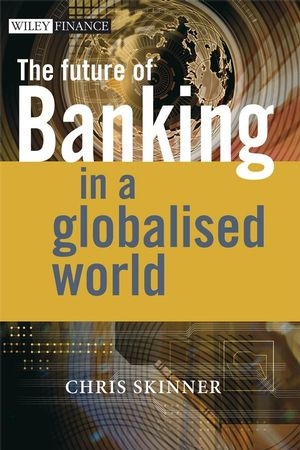
The Future of Banking
John Wiley & Sons Inc (Verlag)
978-0-470-51034-6 (ISBN)
Issues discussed include:
• The impact of emerging markets such as China and India
• Regulatory changes including Europe’s Financial Services Action Plan, MiFID, SEPA, as well as the impact of Basel II and Sarbanes-Oxley
• The latest technologies to impact Bank services from algorithmic trading through Web 2.0
• The displacement of Cash and Cards through Contactless, Mobile and Biometric Payments
CHRIS SKINNER is well-known for his regular columns on Finextra.com and in the Banker magazine, as well as for being a regular keynote at the world’s largest financial services conferences including SWIFT’s SIBOS, BAI in the USA, IIR in Europe and the Financial Times in the UK. When not on the circuit, Chris is Chief Executive of Balatro, a think tank on the future of financial services, and Chairman of the Financial Services Club, a UK-based group which meets regularly to debate the future of the financial markets. He is also Chairman of the Banker's Technology Awards; a Judge with the TradeTech Awards and the Asian Banker's Excellence in Retail Financial Services program; as well as a contributor to the World Economic Forum’s program focused upon the future of banking. He lives in London, England, and can be found regularly at the world's airport lounges gathering views and news on banking worldwide.
Acknowledgments.
Introduction. Challenges for Bankers in the 21st Century.
PART 1 GLOBAL ISSUES.
1. India and China's Impact on Global Banking.
1.1 India versus China, part one: India services the world.
1.2 India's banking: run by civil servants.
1.3 India: the future is still bright.
1.4 India versus China: part two: a Chinese take-away.
1.5 China's banking: a renovation project.
1.6 China's banking: reforming through 2007.
1.7 Lessons to be learnt from China's banks.
1.8 Conclusion: China and India are two tigers you cannot ignore.
2. The Road from Baghdad to Zurich.
3. Faith in Banking.
4. When Two Tribes Go to War.
4.1 Round one.
4.2 End of round one.
4.3 Round two.
4.4 End of round two.
4.5 Round three.
4.6 A clear knockout, but who cleans up?
5. The European Union Unravels.
6. What Goes Around Comes Around.
7 Place Your Bets.
PART 2. RETAIL BANK MATTERS.
8. Strained Relationships.
9. The Banks That Like to Say No.
10. Edupyerryr Syndrome.
11. Call Centre of the Future.
11.1 Year 2008.
11.2 Year 2010.
12. The Big Issue - Fraud and Identity Theft.
12.1 The Internet time bomb.
12.2 The real issue here.
12.3 So what is the solution?
12.4 Biometrics.
12.5 Five-level authentication.
13. Channel technologies Through 2015.
13.1 Background.
13.2 The reality of the internet revolution.
13.3 Authentication technologies.
13.4 Authentication technologies: NFC, RFID and Zigbee.
13.5 Authentication technologies: the question of identity.
13.6 Connectivity technologies.
13.7 Video over internet protocol: critical for retail banking.
13.8 The decline of the keyboard.
13.9 Summary.
13.10 Key developments in front-office banking.
14. Administration Technologies Through 2015.
14.1 The arrival of the 'always-on society'.
14.2 Principles of the 'always-on society'.
14.2.1 If you stand still, you get run over.
14.2.2 Web 2.0.
14.2.3 Application versus platform.
14.2.4 Browsers versus services.
14.2.5 Computers versus devices.
14.2.6 Language versus interface.
14.2.7 Data versus data management.
14.2.8 Users versus participants.
14.2.9 Mass marketing versus collaborative commerce.
14.3 Building the 'ever-ready bank'.
14.3.1 The connectivity and authentication hub.
14.3.2 The information routing hub.
14.3.3 The applications hub.
14.3.4 The hub foundations.
14.4 Summary.
14.4.1 Key developments in back-office banking.
PART 3. PAYMENTS MATTERS.
15. The Cashless, Cardless Society.
15.1 The cashless society.
15.2 The cardless society.
16. Corporates Demand Access.
16.1 XML is one key to the TWIST approach.
16.2 'I'm as mad as hell and I'm not going to take it anymore!
16.3 See me, hear me.
17. SWIFT Changes in Wholesale Payments.
17.1 SWIFT2010 strategy.
18. The Future of Europe's Payments.
18.1 Why force the change?
18.2 The Single Payment Area (SPA).
18.3 How is it going?
18.4 By way of example, I want some euros using my credit card.
18.5 So how have Europe's banks responded?
18.6 STEP2: the Pan-European Automated Clearing House (PE-ACH).
18.7 The melting pot boils.
18.8 The Payments Services Directive.
PART 4. INVESTMENT BANK MATTERS.
19. Best Execution With Best Intentions.
20. Make or Break for Europe's Equity Markets.
20.1 The Markets in Financial Instruments Directive (MiFID).
20.2 The end of Europe's exchanges?
20.3 What will MiFID cost?
20.4 Is that it?
21. To Trade Or Not to Trade?
22. Risky Options.
SIBOS BLOGS.
SIBOS blog 2005: Copenhagen, Denmark.
SIBOS blog 2006: Sydney, Australia.
Appendix 1. Original Articles.
Appendix 2. About Chris Skinner.
Index.
| Erscheint lt. Verlag | 1.6.2007 |
|---|---|
| Reihe/Serie | Wiley Finance Series |
| Verlagsort | New York |
| Sprache | englisch |
| Maße | 175 x 246 mm |
| Gewicht | 567 g |
| Themenwelt | Wirtschaft ► Betriebswirtschaft / Management ► Finanzierung |
| Betriebswirtschaft / Management ► Spezielle Betriebswirtschaftslehre ► Bankbetriebslehre | |
| ISBN-10 | 0-470-51034-X / 047051034X |
| ISBN-13 | 978-0-470-51034-6 / 9780470510346 |
| Zustand | Neuware |
| Haben Sie eine Frage zum Produkt? |
aus dem Bereich


